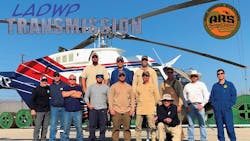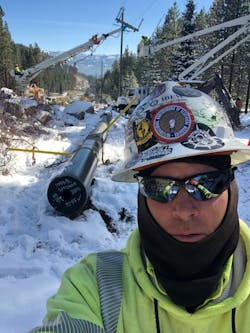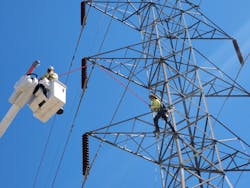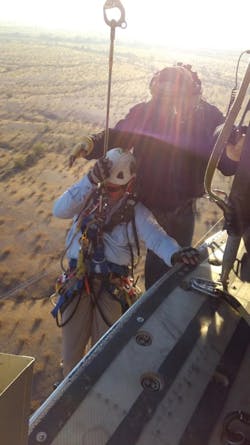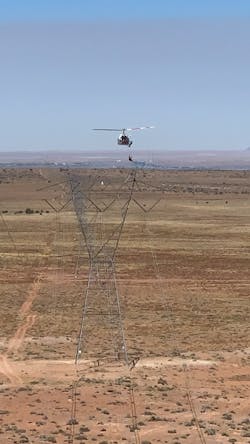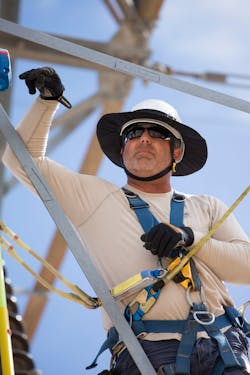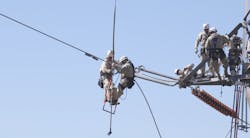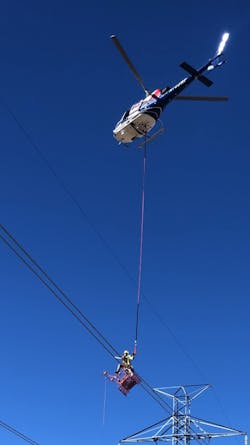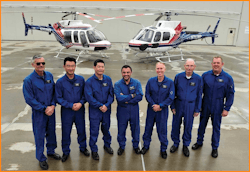Back in the early 1900s, linemen constructed a power line, likely with mules, in the “middle of nowhere” in Arizona. Today, the third largest public power utility, Salt River Project (SRP), uses specially trained transmission line crews to change out the structures through helicopters.
“The lines that we work out here are some of the oldest lines in the system or even in the United States,” said Journeyman Lineman Matt Davis, who serves on SRP’s aerial team. “The linemen who originally built the lines must have been some strong guys because it is still a lot of hard work today with the modern tools and equipment. Some of these structures are on the top of mountains, next to canyons and in rock. How they ever got built in the first place is crazy to me.”
More than a century ago, roads were built to the structures, but over the decades, the ROWs have disappeared. For that reason, Davis said it’s often easier to fly in materials and linemen rather than put the wear and tear on the vehicles. Nationwide, other utilities and line contractors are also leveraging helicopter work to save time and improve the productivity of their field workforce.
While many linemen spend their decades in the line trade working from a bucket truck, a select group are accessing infrastructure from the air. Instead of solely climbing poles and scaling structures, they are instead dropped off at the tops of transmission towers to expedite line work and reach inaccessible locations.
“It is really a rush, and it is fun,” Davis said. “It is something different that not a lot of people get to do.”
Here are the stories of Davis and other aerial linemen who through extensive training, learn how to safely and efficiently, work from the air.
Joe Robertson of IBEW Local 220: Traveling Lineman
For the last decade, Joe Robertson has worked as an aerial lineman. As part of his training through the International Brotherhood of Electrical Workers (IBEW), he has dead ended wire, installed marker balls and dampeners and changed out insulators. He said he enjoys the solitude of helicopter work.
“I think you have a little bit more freedom out there,” he said. “You are secluded. You can be on top of a mountain, and you don’t even hear a bird sing. You just hear your fellow linemen talking back and forth, and you focus on the job and get it done. It’s a peaceful feeling.”
Robertson thought back to the first time he rode in a helicopter, and he recalls feeling like he was in a movie. “The pilot flew me around a little rough to jar me a little bit,” he said. “Flying in sideways to land was interesting.”
Right now, he uses the Human External Cargo (HEC) method. He said this work method has changed over the years. In the past, he remembers flying under the helicopter with a lot of tools in his belt. Today, all the tools are transported separately.
“You have two connection points on your harness, and you are no longer required to carry any working materials,” he said. “Everything is flown in, and it’s just me and my buddy.”
His local has five different two-person crews who are certified to do aerial work. “Training has come 10,000-fold compared to how it used to be,” he said. “We have really good training now.”
For the last two-and-a-half years, he has worked as an aerial lineman for PAR Electric, which has helicopters in its fleet. For several months, he will only perform helicopter work, and then other times, he will focus on other types of tasks. He is trained in not only aerial work, but also distribution and underground.
“We are all over Northern California changing out bells for 500 kV and structures for 60 kV,” he said.
As an aerial lineman, he said it’s important to be prepared to travel for work.
“I have always traveled, so it’s not a big deal to me, he said. “It fits my lifestyle perfectly.”
The 44-year-old plans to retire early, buy a sailboat, and travel via the wind. In the meantime, he said he enjoys training the future linemen, and he takes pride in being patient with those who are new additions to the helicopter team.
“I enjoy training an apprentice or a lineworker who has worked for 40 years but has never done aerial work,” he said.
Matt Davis of Salt River Project: Working Barehand
Davis worked as an outside contractor for IBEW Local 769 for Wilson Construction and Sturgeon Electric before coming to Salt River Project (SRP), where he had the opportunity to join the helicopter team. He is now one of 15 transmission linemen specialized in aerial work and serves on the 500 kV barehand crew for SRP in Arizona.
“I never really came into it to be part of a helicopter crew, but it is always interesting because of the new jobs and different terrain,” said Davis, who has worked in the line trade for the past 15 years. “It’s an awesome experience.”
Davis, who works out of the East Valley Service Center, is part of a crew who performs power inspections and maintenance on hard-to-access transmission lines across the state of Arizona. He and his crew inspect all the hardware and metal components and check out the conductors for any issues through the “climb-and-shake” method.
“By using the hoisting operations with the helicopter, we save a tremendous amount of time,” Davis said. “We inspect 70 to 80 towers a day as a team, and I climb about six to 10 towers each day.”
Many of the towers are inaccessible with a truck, even though they have all-wheel drive. SRP has two large trucks that can reach the tops of the towers, but the helicopters can also drop the linemen on top of the structures, and then they can climb down.
“The 200-ft trucks weigh 90,000 lbs, and there is no way we can get them to every structure,” Davis said. “A helicopter pilot can land five linemen on top of a tower, and we have eight to 10 guys climbing all at one time.”
SRP’s helicopter team uses the HEC method to transport the line crews and hoist them onto the tower. The helicopter pilots then switch over to the long-line method to fly in materials and tools. Last year, SRP performed about 40 structure changeouts in which the linemen changed out towers to poles.
“In those operations, for the first time, we chopped up the tower and flew them out with the helicopter, and then we flew in new poles with the helicopter,” Davis said. “Next year, we will be setting new towers with the helicopters, and we are practicing with the pilots to stack the parts of the tower.”
As part of the aerial transmission crew at SRP, Davis and the other linemen complete an extensive training program for two weeks every year. The training kicks off in the classroom, in which the helicopter pilots review the basic helicopter functions and the ins and outs of helicopter work.
“They treat us like part of the helicopter crew,” Davis said. “We know what to look for so if we don’t like something or something doesn’t seem right, we can point it out to the pilots.”
Next, the helicopter pilots do a dry run in which they train the linemen with the helicopter off. That way, the team can hear each other talking, and the hoist operator has the opportunity to freshen up on his skills. “When the helicopter is running, it is super loud, and you can’t hear anything,” Davis said. “You have to use visual hand signals.”
The linemen then practice doing hoisting operations at 25 ft, 50 ft and 100 ft from the Bell 212 helicopter to the ground and then from the ground to the helicopter. At that point, the crew practices landing on a mock tower in the middle of a field.
“The pilot practices flying us into a tower with no power lines or anything around,” Davis said. “It’s good for the linemen to practice landing on the steel, and it’s helpful for the pilots, who have a good visual of what it’s like.”
Finally, the linemen learn how to land on an actual tower with their 100 percent fall protection. The aerial transmission team uses a device called the Lezard from Petzl to hoist onto the towers. They then secure the lanyard, which is clipped to the helicopter, around the tower, for improved safety.
“We are at a point now where we are 100 percent fall protection,” he said. “There was a point before I got here where they would hoist on to the towers, and for a few minutes, they were not at 100 percent. For the last seven or eight years, we have been at 100 percent, and it has improved safely greatly.”
SRP also uses a twin-engine helicopter for hoisting operations so if one engine fails, the pilot can either complete the task at hand or abort the mission and land the lineman safely on the ground. As an aerial lineman, Davis said he faces the risks of working around heights, helicopters and electricity.
“When we do our tower inspections, all of our 500 kV lines are energized, and there can be isolated statics,” he said. “It is challenging and important to make sure everyone is on their ‘A’ game 100 percent of the time.”
Despite the challenges, Davis said he doesn’t plan on leaving the aerial transmission crew anytime soon.
“The helicopter work is awesome,” he said. “Our crew is open to trying new things that other companies use across the United States. The hoisting operations work great for what we do and the way we use it, and I know there is a lot of cool helicopter work going on nationwide.”
David Katich of Western Area Power Administration: Aerial Patrolman
Over the last 24 years, David Katich, a journeyman lineman for IBEW 769, has served as a groundman, apprentice, lineman and foreman. Today he works as an aerial patrolman for Western Area Power Administration (WAPA).
In this position, he performs an aerial patrol of 3,100 miles of transmission lines every four months and investigates every transmission line relay event within the Desert Southwest region. He also works with crews doing longline, HEC and Energized HEC.
“A journeyman lineman can work all facets of line work from overhead to underground, transmission to distribution, construction to maintenance, de-energized to energized with rubber gloves, hot stick and barehand methods,” said Katich, who completed a four-year apprenticeship program at SRP in Phoenix, Arizona, where he worked for 13 years before coming to WAPA 11 years ago. “Helicopters, cranes and bucket trucks are just the tools used to place lineman in the ‘working position.’
Being successful as an aerial lineman requires dedication, work ethic, pride, confidence, leadership and a never-ending desire to learn, he said. Generally, he said the helicopter is just an additional tool that is added to a line work project. To learn how to perform aerial work, linemen must attend WAPA’s 64-hr HEC training program to review specific procedural and safety concerns as they relate to the helicopter. For example, they learn how to use a small digital weight scale, which connects via Bluetooth to a phone, to monitor the weight of linemen, tools and equipment.
In addition, linemen must perform the individual HEC work methods and procedures before he or she is qualified to perform HEC work. WAPA has HEC lines for de-energized work and specialized HEC lines for energized work up to 500 kV.
"The HEC equipment has advanced in both technology and materials over the last 10 years,” he said. “WAPA now uses dual hooks on its helicopters for additional redundancy.”
The safety precautions are the same as any other line crew, said Katich, who serves as the co-chair of WAPA’s Fall Protection Committee, Apprenticeship Committee, HEC Committee and Unmanned Aerial Systems (UAS) Committee.“
Working out of a crane basket is the same as working out of an air-chair,” he said. “The helicopter has a few specific safety hazards that need to be addressed but it’s just a different tool being used to support the line crew.”
With aerial work, however, linemen must stay focused and remember that “slow is fast,” Katich said.
“The biggest challenges are maintaining situational awareness and being able to anticipate events before they happen,” Katich said. “For example, it’s very easy for tunnel vision to set in and miss the big picture when making the transfer from the HEC line to a transmission structure.”
He said being transported in a helicopter to a job site takes some getting used to. “Just imagine four linemen with tools being crammed inside a minivan,” he said. “It’s much more enjoyable on the HEC line or in the air-chair underneath the helicopter. The favorite part is the few minutes between the landing zone and the work site where you can just enjoy the ride.”
During his career, he said one of the most memorable aerial experience was working on a project at Hoover Dam.
“We watched hundreds of tourists visiting an engineering marvel of the world,” he said. “They then changed focus and all pulled out their phones to watch the helicopter with the lineman underneath flying back and forth. It’s just something that captures people’s imaginations.”
In the future, he plans to continue to learn new work methods. For example, WAPA has recently developed a UAS program where linemen have FAA Part 107 licenses and can fly drones.
“Integrating UASs with the line crews brings additional capabilities for asset inspections for maintenance crews,” he said. “Being able to inspect the static wire connection on a 500 kV tower from the ground without climbing the tower? Sign me up.”
Jim Schultz of Los Angeles: Department of Water & Power-HEC is a Team Effort
Jim Schultz. electrical distribution mechanic supervisor for LADWP’s Metro Transmission Headquarters, has worked in the line trade for 36 years. He jumped at the opportunity to work with the helicopter team when he saw all of the benefits the HEC program would have on his section.
The HEC crews consist of pilots, patrolmen and foremen, and they participate in training sessions at one of LADWP’s generating stations and a hangar.
“All of our pilots are very familiar with line construction, rigging, tower rescue operations and our work practices,” he said. “We work and train together as crew members, not just passengers or linemen. We are very fortunate to have the pilots, journeymen and supervisors that we have in our HEC program, or it wouldn’t be as successful as it is.”
All crew members participate in an extensive safety tailboard covering helicopter operations, work procedures, emergency operations and risk management.
“We decide as a group to go ahead with the mission or find another way to do it,” he said. “Linemen are thinkers and doers. We can always figure out how to get the job done in a safe and efficient manner.”
In the transmission department, LADWP performs both short-haul and long-line operations. The pilots also perform long-line work throughout the department for other groups.
To improve comfort and safety for the linemen, LADWP invested in new air chairs, which Schultz said has increased stability when flying doubles. The crews are also always working on and improving safe work practices to perform daily operations.
“We have established a cohesive group between aviation services and the transmission section,” he said. “Our pilots do an amazing job and that makes our job that much easier.”
For those linemen considering aerial work, he said it’s important to have a good work ethic, keep safety in mind and always have their crew members’ backs.
Retirement is on the horizon for Schultz, but he said he knows the HEC program will be in good hands when he leaves LADWP.
“We all have to keep in mind that it’s a group effort to keep the program as tight as it is,” Schultz said.
He said he appreciates not only the linemen, but also their families, for their support of the trade. “Thank you to all the linemen who spend countless hours away from home and their families to keep the lights on,” he said. “It’s a commitment and a way of life that only a lineman knows. And thank you to the line wives. We couldn’t do it without your support.”
Hoisting Linemen: Step by Step
In normal hoisting operations, Salt River Project has two pilots and a hoist operator, who communicates with the pilots via radio. Here is how the team works together to land the lineman safely on the top of a structure.
- The team separates into crews with four or five linemen in the helicopter at one time. The linemen exit from the front or back seat to distribute the weight in the helicopter.
- The lineman who is exiting the helicopter sits at the door as the hoist operator hooks the hoist onto his harness. The hoist operator then taps the lineman on the leg to signal for him to disconnect his safety from the floor and fully attach to the hoist.
- The lineman steps out and places his or her feet on the skid or sits into his or her harness and floats on the hoist.
- The hoist operator then taps the lineman on the shoulder, and down the lineman goes.
- In less than 30 seconds, the lineman is on the tower, and the pilot flies away.
About the Author
Amy Fischbach
Electric Utilities Operations
Amy Fischbach is the Field Editor for T&D World magazine and manages the Electric Utility Operations section. She is the host of the Line Life Podcast, which celebrates the grit, courage and inspirational teamwork of the line trade. She also works on the annual Lineworker Supplement and the Vegetation Management Supplement as well as the Lineman Life and Lineman's Rodeo News enewsletters. Amy also covers events such as the Trees & Utilities conference and the International Lineman's Rodeo. She is the past president of the ASBPE Educational Foundation and ASBPE and earned her bachelor's and master's degrees in journalism from Kansas State University. She can be reached at [email protected].
